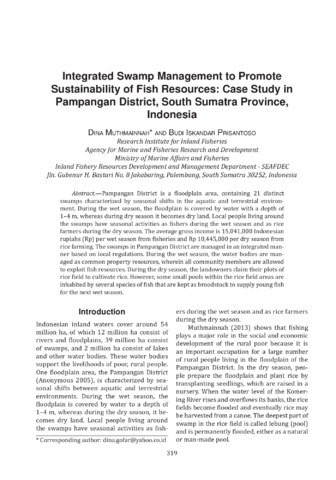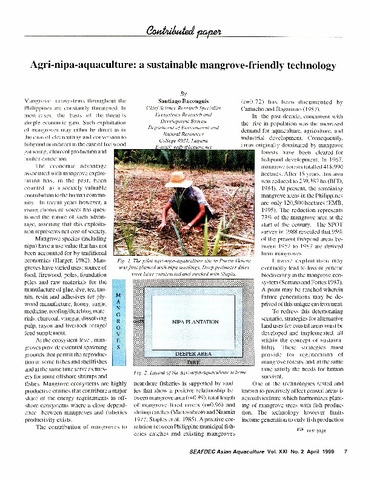Promoting strategies for sustainable management of swamp fisheries in the Southeast Asian Region
Share
abstrak
Recognizing the vital role of swamps in the Southeast Asian region, the Inland Fishery Resources Development and Management Department of SEAFDEC (SEAFDEC/IFRDMD) delved into various approaches to ensure the long-term viability of the aquatic resources. Key considerations include the conservation of biodiversity, effective regulation of fishing practices, and community engagement in resource management. By integrating scientific insights with local knowledge and stakeholder collaboration, SEAFDEC/IFRDMD proposed strategies to address the complex challenges in swamp fisheries while fostering their sustainable utilization for the present and future generations. Swamp fisheries are crucial for food security and livelihood as well as for biodiversity conservation and ecosystem services. However, swamp fisheries are threatened by issues and challenges including overfishing, habitat degradation, climate change, invasive species, pollution, lack of data and research; and policy and governance gaps. In 2020–2024, SEAFDEC/IFRDMD implemented the project “Management Scheme of Inland Fisheries in the Southeast Asian Region” supported by the Japanese Trust Fund 6-2. SEAFDEC/IFRDMD conducted studies in a Special Area for Conservation and Fish Refugia (SPEECTRA) in Patra Tani in Indonesia. SPEECTRA is being promoted in the Southeast Asian region as a model for swamp fisheries conservation. The Project was intended to address the issues stipulated in the Resolution and Plan of Action on Sustainable Fisheries for Food Security for the ASEAN Region Towards 2030 (RES&POA-2030), specifically POA No. 44 Promote Research and Development (R&D) to understand the migration patterns, spawning grounds and seasons, and nursery grounds of important inland aquatic animals; and ensure the sustainability of inland fisheries by maintaining health of the ecosystem, particularly the inter-connectivity of habitats and the specific management needs during the dry season as well as POA No. 47 Formulate guidelines to promote the use of practical and simple indicators for inland/floodplain fisheries within the national inland fisheries management framework, to facilitate (i) timely local level fisheries management decisions with due respect to the large number of people/farmers that take part in fishing; (ii) dialogues to ensure that the inter-connectivity of fish migration path is kept as a tool for management/conservation measures; and (iii) adaptation to the effects of climate change within water bodies.
Keywords
Swamp floodplain inland fisheries conservationSuggested Citation
Supriyadi, F., Muthmainnah, D., Rais, A. H., Sawestri, S., Anthoni, R., & Shimizu, T. (2024). Promoting strategies for sustainable management of swamp fisheries in the Southeast Asian Region. Fish for the People , 22(2), 16-23. http://hdl.handle.net/20.500.12066/7522
Subjek
Koleksi
Related items
Showing items related by title, author, creator and subject.
-
Impact of auction system for swamps on sustainability of fishery resources: a case in South Sumatra, Indonesia
Yanti, Bayu V. I.; Muthmainnah, Dina (Secretariat, Southeast Asian Fisheries Development Center, 2021-01-30)Management of swamps in several parts of Indonesia is carried out using an auction system, which is also known as “lelang lebak lebung” in South Sumatra, and has been practiced for generations. A study was carried out ... -
Integrated swamp management to promote sustainability of fish resources: Case study in Pampangan District, South Sumatra Province, Indonesia
Muthmainnah, Dina; Prisantoso, Budi Iskandar (Food and Agriculture Organization of the United Nations; Michigan State University; American Fisheries Society, 2016)Pampangan District is a floodplain area, containing 21 distinct swamps characterized by seasonal shifts in the aquatic and terrestrial environment. During the wet season, the floodplain is covered by water with a depth of ... -
Agri-nipa-aquaculture: a sustainable mangrove-friendly technology
Baconguis, Santiago (Aquaculture Department, Southeast Asian Fisheries Development Center, 1999)






